A graphic (such as a Menu) played on a NTSC television may have special requirements. If you use saturated reds or yellows, they may "bleed" on the TV screen, other colors
may appear washed-out or some parts may flicker even though the same content looks perfectly fine on your computer monitor.
Most DVD and video professionals are aware of this problem, but they often don't exactly know what is the cause of it. You often get half-cooked advice like "don't use saturated reds", etc.
![]() Note: Some engineers even refer to NTSC as "Never Twice the Same Color"
(PAL is sometimes de-abbreviated to "Perfection At Last").
Note: Some engineers even refer to NTSC as "Never Twice the Same Color"
(PAL is sometimes de-abbreviated to "Perfection At Last").
DVD-lab's NTSC Overheat window shows possible Menu problems and lets you to check how the Menu will appear after automatic NTSC Safe Color filtration. It will also visually pinpoint which colors are causing the problem, so that you may change your design to remove or alter these colors. NTSC Overheat demystifies the NTSC color situation and has educational value as well.
![]() NTSC Safe Color filter
NTSC Safe Color filter
DVD-lab has implemented one of the most accurate NTSC Safe Color filters available which goes hand in hand with the Overheat calculation. This
exactly filters out the colors that may cause problems. The result will be a very smooth looking image without any big color changes and ready to display on NTSC. The filter is automatic, that means once you enable it in Properties you are done. This is an advanced tool. Some video professionals pay more than the entire cost of DVD-lab, for less accurate plug-ins.
![]() NTSC Overheat
NTSC Overheat
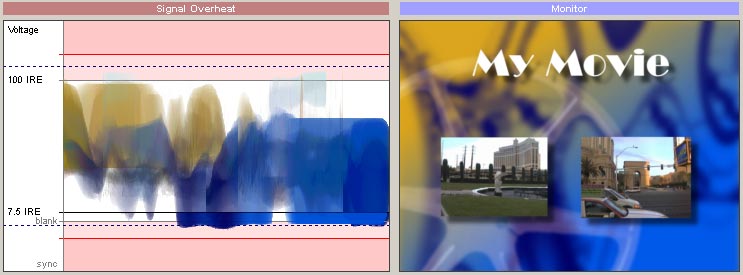
The signal Overheat window shows how signal travels through the video composite wire.
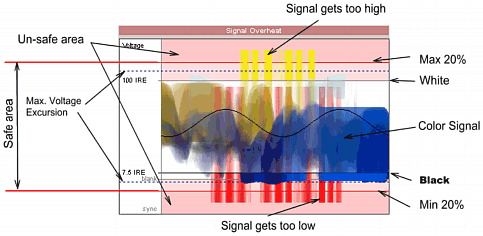
In the center between "Blank" 0 IRE and 100 IRE you will see the video signal (color-coded as to the actual color which produced it). The top and bottom red lines determine the 20% maximum and minimum limit under 0 IRE and over 100 IRE as defined by NTSC specifications. Signals which go higher or lower than these range boundaries are considered an "unsafe" signal and may produce bleeding, shaking and loss of sync.
Notice the picture below:
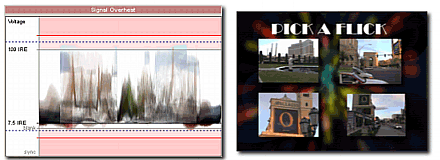
The signal is entirely within the allowed area between the red lines. That means, this Menu is already a NTSC Color Safe Menu, it will not be visually changed by the NTSC Safe Color filter.
Here is another Menu. In this Menu we boldly set a text object to be red and yellow (two colors well known as bad Colors on a NTSC TV).
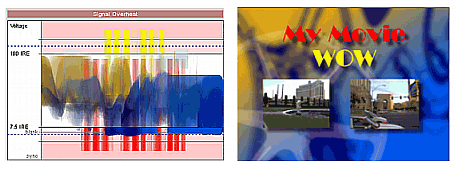
You immediately notice that the yellow and red signals go way out of the safe area boundary into the unsafe area. Here the NTSC Safe Color feature will be automatically applied and the colors will change accordingly.
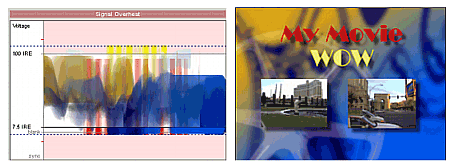
This is the Menu and signal after the NTSC Safe Colors feature was applied.
![]() Maximum Voltage Excursion.
Maximum Voltage Excursion.
The dashed line shows our "Maximum Voltage Excursion" setting - this is a value beyond what we don't want any signal. This is the value NTSC Safe Color Filter uses to calculate new safe colors boundaries.
The values are from 0-20% but around 10%-15% produces best result. If you set 0% then the signal will be strictly set to go from blank 0 IRE to 100 IRE. This will however change the Menu colors quite a bit since many colors goes beyond this.
If you set value bigger than 20%, then the signal is allowed to go beyond the red lines into the unsafe area. Logically then, you should not set this to be higher than 20%. Since NTSC allows for 20% excursion, the best values are about 15%, the color doesn't change as much as with 0%, but it is still within in the safe 20% area with 5% reserve.
![]() Note: The voltage value is in IRE measurements. The actual voltage in Volts may differ between systems and countries, so IRE is a relative measurement, the 100 IRE may be 1 V, or sometimes 0.75V etc... In the US version of NTSC the black is set as 7.5 IRE (shown on graph), while in Japanese NTSC the black is set to 0 IRE (shown as "blank").
Note: The voltage value is in IRE measurements. The actual voltage in Volts may differ between systems and countries, so IRE is a relative measurement, the 100 IRE may be 1 V, or sometimes 0.75V etc... In the US version of NTSC the black is set as 7.5 IRE (shown on graph), while in Japanese NTSC the black is set to 0 IRE (shown as "blank").
Do I need to worry about the NTSC settings?
You actually don't. Once you have set NTSC Safe Colors in the Properties then you are safe. You can just go to the Overheat window to check how the Menu will change or set the maximum Voltage Excursion to better suit your taste.
![]() A little technical explanation.
A little technical explanation.
While all computer graphics are mostly RGB, this is not the color space which our brain understands. Our mind perceives color as a combination of brightness and two additional color
components. YUV color space tries to reflect this. NTSC uses a similar YIQ color space to create composite signal. The I (in-phase) and Q (quadrature) are modulated together and then Y (brightness) component is added. As you can see, these three components are mixed together to create a composite signal which travels through a single wire.
Because of the YIQ color space conversion, the highly saturated colors also generates higher voltage changes than for example: black and white. If a white color has a voltage of 1V and black 0V then yellow will have 1.33 V and red -0.33V.
Because of the backward compatibility with older B/W NTSC TV sets, the NTSC specs specify that video signal is not allowed to go more than 20% above white and 20% below black voltage levels. But some colors such as yellow or red actually go higher or lower than that (yellow +33%) !
This limitation in NTSC is the main cause of the problem. Also, the video sync signal is mixed to the YIQ signal. Colors such as red can go so low with voltage that they can even affect the sync signal and you can lose synchronization on some TV sets because of that.
PAL doesn't have this backward compatibility limitation.